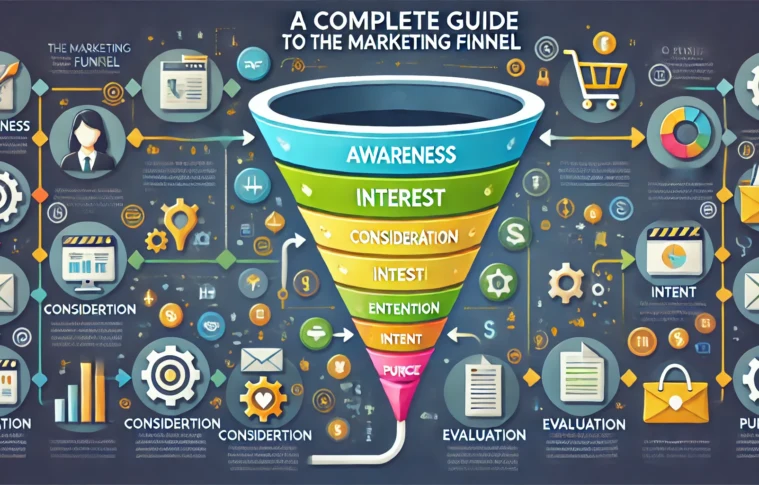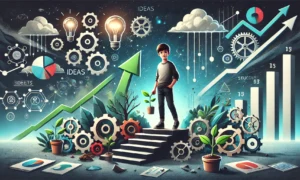In today’s competitive business environment, businesses cannot afford to adopt a “spray and pray” approach to marketing. The marketing funnel helps companies streamline their strategies, making it easier to attract, engage, convert, and retain customers. This structured approach allows businesses to address the needs of their customers at each stage and optimize their efforts toward meaningful outcomes.
This blog explores the significance of the marketing funnel, breaking down its role at various stages and how it aligns with business growth.
What is a Marketing Funnel?
A marketing funnel is a step-by-step process that leads a potential customer from the first point of interaction with a brand to the moment they make a purchase (and beyond). The funnel metaphor works because many people enter at the top, but fewer reach the bottom as loyal customers.
Stages of a typical marketing funnel:
- Awareness – The potential customer discovers your brand.
- Interest – They become curious and seek more information.
- Consideration – The customer evaluates your product/services.
- Conversion – They make a purchase or take the desired action.
- Retention and Advocacy – They return for more and recommend your brand.
Why is the Funnel Important in Marketing?
1. Understanding the Customer Journey
The marketing funnel allows businesses to visualize how a customer interacts with their brand at every touchpoint. It offers clarity on which stage customers are at and provides actionable insights to nurture them through to the next phase. Knowing where your audience is in their journey ensures you engage them with the right message at the right time.
Example: If a customer is in the awareness stage, offering detailed product features might overwhelm them. At that point, introducing a simple video ad or blog post would be more effective.
2. Improves Targeting and Personalization
The funnel helps marketers segment their audience based on where they are in the journey. A well-executed funnel ensures campaigns are personalized and specific to each stage. This personalized approach improves the customer experience and maximizes engagement, driving higher conversions.
How it helps:
- At the top of the funnel (TOFU), you can run educational content campaigns to build awareness.
- At the middle of the funnel (MOFU), product comparisons and case studies work better.
- At the bottom of the funnel (BOFU), free trials or discount offers may encourage purchase.
3. Reduces Wastage of Marketing Resources
The structured nature of a funnel ensures you are investing your time, budget, and resources effectively. Rather than trying to convert cold audiences who are not ready to buy, the funnel directs your marketing spend toward high-intent prospects, optimizing your return on investment (ROI).
4. Better Forecasting and Growth Planning
The funnel provides key metrics such as conversion rates and drop-off points, which give a clear picture of where your marketing efforts are succeeding and where they need improvement. This data empowers businesses to make informed forecasts about revenue growth and customer acquisition, ensuring a more predictable marketing performance.
5. Boosts Customer Retention and Loyalty
A well-designed funnel goes beyond one-time sales. The post-purchase phase includes retention and advocacy, which help increase customer lifetime value (CLV). Loyal customers tend to make repeat purchases and become brand advocates, promoting your business through word of mouth.
Retention tactics include:
- Loyalty programs
- Personalized follow-up emails
- Post-purchase surveys to improve future offerings
Key Metrics to Track at Each Funnel Stage
- Awareness: Website traffic, social media impressions, content engagement
- Interest: Click-through rates (CTR), email open rates, time spent on pages
- Consideration: Lead-to-opportunity ratio, cart abandonment rate
- Conversion: Cost per acquisition (CPA), conversion rate
- Retention: Repeat purchase rate, Net Promoter Score (NPS)
How to Optimize Your Marketing Funnel
Here are some ways you can ensure your funnel delivers maximum results:
- Map the Funnel to Your Buyer Persona: Understand your audience’s pain points and design the funnel stages around their needs.
- Leverage Marketing Automation: Use CRM and automation tools to engage prospects with timely messages.
- A/B Test Your Campaigns: Identify what messaging and content work best at each stage.
- Analyze Drop-off Points: Track where users are leaving the funnel and improve those touchpoints.
Conclusion
A well-structured marketing funnel is the backbone of every successful business. It offers a clear roadmap for turning prospects into loyal customers and helps allocate resources efficiently. With data-driven insights at every stage, businesses can make strategic decisions, increase conversions, and foster long-term growth.
If your business isn’t yet leveraging a funnel, now is the time to build one! A clear and optimized marketing funnel ensures that every step you take brings your customer closer to the ultimate goal—creating meaningful, lasting relationships that drive success.
Ready to take your marketing to the next level? Start building your funnel today and watch your business grow 10x!



